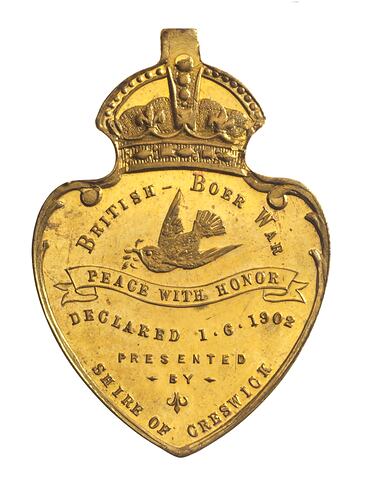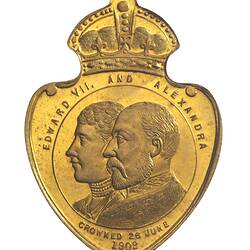Creswick is a former gold-mining township 20 km. north of Ballarat, set in undulating ranges, partly forested. It existed as a Municipality from 1859 to 1995.
It was named after the Creswick Creek pastoral run, taken up by brothers Henry, Charles and John Creswick in 1842. Ten years later gold was discovered on Creswick Creek. Most leads ran north of the future township site, but one ran southwards, just east of the town centre. A goldfields Commissioner, Walter Brackenbury, was appointed in 1852, and his Commissioner's Camp (Bridge Street) later became the site of the Botanic Gardens. The first school opened in 1853, and in August 1854 a township survey was carried out. Religious and civic institutions were quickly established: Anglican and Catholic churches (1857), a Wesleyan church (1861) and a court house (1859).
More than 25,000 miners are thought to have been in the Creswick area at the peak of the gold rush. The census for 1861, however, recorded a population of 4,714, which was to be the highest census figure ever. The easy alluvial gold was quickly won, and deep lead mining became the main focus of mining after the early 1870s, particularly to the north of Creswick. Notable mines were the Madame Berry and the New Australasian. North and east of Creswick hills with good volcanic soil was first used for growing wheat and oats. As grain growing moved northwards in Victoria, sheep and cattle grazing took over, with potato growing continuing in fertile pockets. South of the township the hillier country was used for timber harvesting.
In 1859 a town road board was established, becoming a borough in October 1863. In the same year a hospital was built, a gold office opened and a grammar school founded (it was relatively short-lived, closing in 1903). In 1861 a School of Mines and Technology was opened, and in 1863 the town finally gained a hospital.
In 1864 Dr. Robert Lindsay set up his practice in Creswick and in 1866 moved to a house at the corner of Raglan and Cambridge Streets. His son Norman, author and painter, depicted aspects of Creswick in three of his novels, Saturdee, Red Heap and Halfway to Anywhere. Another son, Percy, painted numerous scenes of Creswick, of which over twenty are in the Ballarat Fine Art Gallery Collection. In 1874 the railway was connected and a station complex opened, and in 1876 a town hall was completed.
Creswick was the birthplace of other notable Australians: John Curtin (1885), Labor Prime Minister of Australia, 1941-45; Sir Alexander Peacock (1861), Victorian Premier, 1901-02, 1914-17 and 1924; and Thomas Laby (1880) physicist. W.G. Spence (1846) lived in Creswick during the time of the Eureka rebellion, was secretary of the Creswick Miners' Union and went on to found the Australian Workers' Union and became a Federal Parliamentarian.
In 1882 the New Australiasian gold mine was the scene of a disaster when twenty-two miners were drowned in a flooded shaft. It was the greatest recorded loss of lives in an Australian mine.
Although local forests had been denuded for mine timber and firewood, plantings by Government foresters began in the 1880s, and in 1909 a forestry school was opened a few hundred metres east of Creswick. Between 1910 and 1980 the school trained 500 foresters, and its site is surrounded by landscaped gardens with extensive pine plantations beyond. The forestry school influenced the laying out and planting of parks and street trees which give Creswick a high level of landscape quality.
Creswick's main public space is Calambeen Park in Cushing Street, the site of the Chinese camp (much in decline when painted by Percy Lindsay in 1894), mined by sluicing around the turn of the century. A swimming pool (1910) was constructed in a hole made by the sluicing.
Crewsick was one of thousands of towns around Australia which sent soldiers to the Boer war, and it combined its commemoration of this sacrifice with an expression of its loyalty to the newly crowned Edward VII in a medal issued in 1902 (NU 20242). The Borough of Creswick was united with Creswick Shire on 29 May 1934.
On 19 January 1995 Hepburn Shire Council was created by Order of the Governor in Council from the Shires of Creswick, Daylesford and Glenlyon, parts of the Shires of Kyneton and Talbot and Clunes.
Creswick today has an extensive stock of historic buildings, particularly cottages and houses, ranging from miners' dwellings to substantial two-storey houses built by successful professionals.
References:
Australian Places website, Monash University, http://arts.monash.edu/ncas/multimedia/gazetteer/list/creswick.html, 24/11/2003.
More Information
-
Keywords
-
Localities
-
Authors
-
Article types

